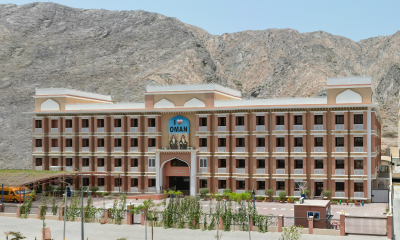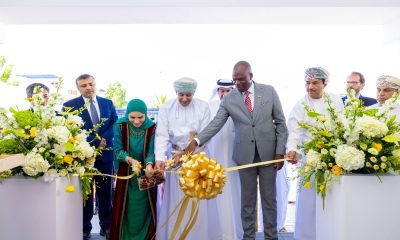News
Arab oil-exporting countries expected to record low pace of economic growth in 2016-17 compared to oil importing countries: Report
As part of its continuous efforts to support policy makers in the Arab region, the Arab Monetary Fund (AMF) releases March edition of the “Arab Economic Outlook” report which includes projections for the macroeconomic performance of Arab Countries in 2016 and 2017.


As part of its continuous efforts to support policy makers in the Arab region, the Arab Monetary Fund (AMF) releases March edition of the “Arab Economic Outlook” report which includes projections for the macroeconomic performance of Arab Countries in 2016 and 2017.
The report has outlined the challenges facing the world economy in the next two years. It is expected that OPEC producers will reach an agreement not to further increase oil production level, which in conjunction with the decline in oil shale production will strengthen oil prices and bring about a relative stability in the oil market. It is projected that the average price of oil will be $40 per barrel in 2016.
The major challenge facing the world economy is the weak performance of emerging markets economies and developing countries as a result of declining world trade and capital flows. On the other hand, the performance of developed economies will benefit from the impact of lower oil prices with a positive spill over effect on some Arab economies being their major trading partners.
The focus is again on the Chinese economy which is going through structural changes to boost economic growth through a shift from export led to a domestic demand driven growth. While in the Euro Area, there is still need for structural reform in some major economies in order to emulate the positive economic performance witnessed by Spain. On the other hand, the picture looks more challenging for commodity exporting countries, such as Russia and Brazil, while India is expected to sustain its positive performance in light of the reforms initiated by its government in the last two years. The US economy is projected to maintain a positive growth rate even as export growth to fell short of expectations this year. The appreciation of the US Dollar seems to be the most significant constraint to US export growth, and a factor behind the increase of debt service on the US denominated debt of emerging and developing economies.
Regarding Economic Growth, the report noted that the macroeconomic performance of Arab countries has been affected in 2015 by the persisting sluggish recovery of the world economy and international trade, as well as lower commodity prices, notably oil, whose prices in 2015 was 49 percent lower than that recorded in the previous year. In addition, internal developments impacted economic growth in some Arab countries. Against this background, a number of Arab oil-exporting countries have increased oil production to partially lessen the impact of falling oil prices on their internal and external balances.
Furthermore, some of these countries, especially Gulf Cooperation Council countries (GCC) resorted to maintaining public spending at levels supportive of economic growth with a focus on achieving fiscal sustainability. Arab oil-importing countries economic performance on the other hand, has benefited from several factors for the second consecutive year, notably the gradual improvement of internal conditions, lower oil prices, and from the implementation of structural reforms adopted since 2011. As a result of these developments, economic growth rate of the Arab economies as a group is estimated to reach 3.2 percent in 2015.
In 2016, the growth rate of Arab countries is expected to be affected by global economic environment and the internal conditions in some Arab countries, as well as the impact of fiscal reforms. However, the rapid pace of growth of Arab oil-importing countries will relatively alleviate part of the negative consequences of the aforementioned factors on the growth of Arab countries as group which is expected to reach 2.8 percent in 2016, before recovering to 3.1 percent in 2017, amid expectations of partial recovery of oil prices and global economy.
The uneven performance is still to remain between different groups of Arab countries. Arab oil-exporting countries are expected to record low pace of economic growth in 2016 and 2017 compared to Arab-oil importing countries which are expected to grow at a faster pace. The Arab Economic Outlook report, expects the growth rate of Arab oil-exporting countries to reach 2.6 percent in 2016, and to recover to 3.1 percent in 2017. Growth rate of GCC is forecasted to be 2.5 percent in 2016, reflecting mainly the developments in the global oil market and the impact of fiscal corrective measures. In 2017, the growth rate of this group is estimated to recover to 2.6 percent supported by the likely increase in international oil prices. Other Arab oil-exporting countries are projected to grow by 3.8 percent in 2016 and 6.7 percent in 2017, provided that a relative improvement in internal conditions is achieved over the concerned period. Needless to say that expected high growth rates of this group reflect the lower base of growth in the previous years.
On the other hand, Arab oil-importing economies are expected to grow at a high pace of 3.8 percent in 2016 and 4.3 percent in 2017, in line with expectations of gradual improvement in domestic conditions and the recovery of key economic sectors due to anticipated better performance of global economy and international trade. Furthermore, these countries would also benefit from the implementation of economic reforms aiming at increasing productivity and enhancing competitiveness.
With respect to Inflation Forecasts, inflation rate for Arab countries as a group declined to 6.5 percent in 2015 compared to 8.1 percent in 2014. The AMF report referred to a group of factors that affected domestic price levels in Arab countries in 2015. On top of these factors, the decline in imported inflation either due to lower international oil prices or as a result of the appreciation of the US dollar against some other major currencies, in addition to the impact of lower economic growth and tightening of monetary policy in some Arab countries. On the other hand, some Arab countries witnessed inflationary pressures resulted from policies that have been adopted to reduce subsidies.
In 2016, the report expects inflation rate for Arab countries as a group to rise to 7.4 percent in 2016, reflecting the inflationary pressures resulted from the ongoing governments’ efforts to reform subsidy systems. In addition to the expectations of increased inflation rates augmented by demand pull factors, due to the expected rise in wages and salaries in some Arab countries. On the other hand, the shortage in the supply side for goods and services in some Arab countries that witness internal developments will be reflected on the domestic price level in these countries.
Furthermore, some Arab countries will witness inflationary pressures due to the depreciation of their local currencies. These circumstances could increase the pass through effect of local currencies depreciation to the domestic prices. On the contrary, the decline in oil prices combined with the reduction in investment expenditure would lessen inflationary pressures in a number of Arab countries this year. In 2017, inflation rate in the Arab countries as a group is expected to rise to about 8.1 percent in light of the anticipated relative increase in the global prices of oil and basic commodities, due to the expected improvement in global economic performance.
On the Monetary Policy front, most Arab countries with fixed exchange rate regimes increased their overnight deposit rates by 25 bps in response to the US interest rate hike. Oil exporting Arab countries face the challenge of decreasing oil prices with the possibility of increasing their interest rates to follow the expected increases in rates in the United States throughout 2016 and 2017.
While in oil importing Arab countries, decreasing commodity prices help dampen headline inflation, especially for those countries which have fully liberated energy prices. Yet the challenge for some of those countries is the continuous depreciation in their currencies which adds inflationary pressures on their economies.
As for Banking Developments, lower oil prices and an economic slowdown in oil exporting countries are expected to negatively affect the growth rate of deposits, especially considering the size of their financial systems. Yet, the main challenge in the coming years is to maintain a low level of non-performing loans, highlighting the importance of sustaining government expenditure levels to boost domestic demand without jeopardizing fiscal sustainability.
In terms of Public Finance, the declining trend of oil prices has influenced public finance situation in Arab countries in diverse ways. The Arab oil-exporting countries have been affected negatively by the lower international oil prices which significantly lowered oil revenues (the major source of Arab consolidated public revenues) by 42 percent in 2015. On the other hand, lower oil prices eased pressures on public finance in Arab oil-importing countries, especially in light of the rising cost of energy subsidies. As a result, the estimated consolidated budget deficit for the Arab countries as a group is estimated to increase to 11.4 percent in 2015 compared to 2.8 percent of GDP in 2014. In this context, it is very obvious the tendency of many Arab countries to implement wide and diversified range of fiscal reforms aiming at rationalizing public spending, enhancing public revenues to ensure budget consolidation and fiscal sustainability, particularly in the light of the challenges facing fiscal policy in these countries.
Tax reform came at top of these reforms, as several reforms have been implemented in a number of Arab countries to enhance tax revenues and ensure equitable and efficient tax system through revising income and corporate tax systems, adoption or reforming value added tax, and directing taxation to support small and medium-sized enterprises and promising regions. On the other hand, several policies have been implemented to lower public spending mainly through rationalizing current expenditures via containing increases in payroll expenses and reforming subsidy systems, in addition to measures to increase the efficiency of capital expenditures. Arab governments also, paid great attention to achieve higher levels of efficiency and transparency of public finance and debt management.
Consolidated budget deficit of Arab countries as a group is expected to rise slightly in 2016, to 11.6 percent of GDP, as oil revenues will continue to decrease, while tax revenues are expected to be affected by sluggish growth at the international and regional levels. Nevertheless, public spending is projected to decrease by 6 percent this year as a result of fiscal discipline policies, which will help reduce pressures on consolidated public budget of Arab countries as a group. In 2017, public finance is expected to see a significant improvement, amid expectations of higher revenue as a result of expected increase of oil prices by 15 percent next year. Furthermore, tax revenues are expected to rise owing to the anticipated expansion of economic activity in the Arab countries and their major trading partners.
Moreover, the consolidated public budget will positively benefit from fiscal reforms implemented in Arab countries within time frame extending to 2020. As a result, public budget deficit for the Arab countries as a group is forecasted to decline to 7.8 percent as percentage of GDP in 2017.
Concerning External Sector, the declining trend of oil prices will continue its impact on the performance of current account of the Arab countries as group during 2016. However, the relative recovery of the Euro zone would affect positively the performance of non-oil exports of Arab countries. In addition, the US dollar interest rate hike will reflect positively on the proceeds of the investment income for Arab countries. As a result the report expects that the current account deficit for Arab countries as a group will reach USD 137.8 billion dollars (representing 5.5 percent of GDP) in 2016 compared with USD 105.7 billion dollars for the deficit recorded in 2015. Concerning 2017, the report expects that the current account deficit for Arab countries as a group to decline to USD 97 billion dollars (representing 3.6 percent of GDP), amid expectation of relatively higher international oil prices next year.
-

 Banking & Finance2 weeks ago
Banking & Finance2 weeks agoOman Oil Marketing Company Concludes Its Annual Health, Safety, Environment, and Quality Week, Reaffirming People and Safety as a Top Priority
-

 Economy2 months ago
Economy2 months agoMaal Card: What Oman’s New National Payment Card Means for Everyday Users
-

 News2 months ago
News2 months agoSheikh Suhail Bahwan, Chairman of Suhail Bahwan Group, Passes Away
-

 News1 month ago
News1 month agoOIG Appoints New CEO to Lead Its Next Chapter of Excellence
-

 Economy2 months ago
Economy2 months agoOman Unveils Official Omani Rial Symbol in Landmark Move to Boost Global Currency Presence
-

 News1 month ago
News1 month agoReport: How India & The Middle East Are Exploiting Immense Economic Synergies
-

 Uncategorized1 month ago
Uncategorized1 month agoOman’s ISWK Cambridge Learners Achieve ‘Top in the World’ and National Honours in June 2025 Cambridge Series
-

 Trade1 month ago
Trade1 month agoConsulate Office of the Republic of South Africa opens in Muscat, enhancing bilateral relations





























You must be logged in to post a comment Login